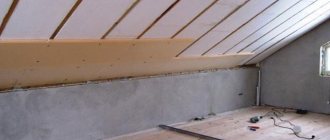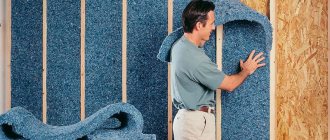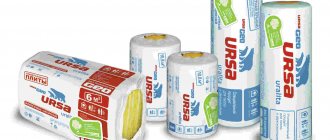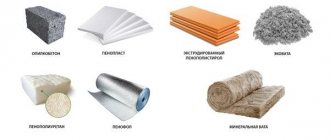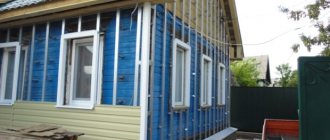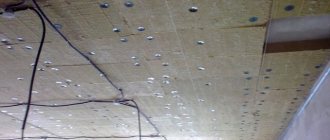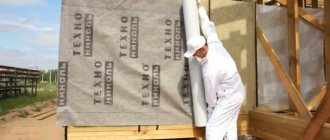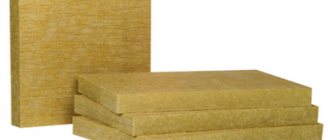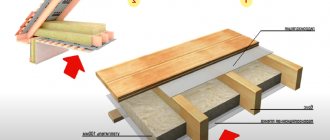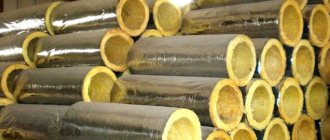The market for thermal insulation materials is replete with offers for every taste. Mineral wool, polystyrene foam and polyurethane foam have long established themselves as reliable and safe thermal insulators. However, science does not stand still, and manufacturers are always striving to expand their market share with new products.
A relatively “young” thermal insulation material is XPS (eXtruded PoliStyrene) insulation. This is the name given to extruded polystyrene foam. Thanks to its unique combination of characteristics, the material has gained recognition among a large number of buyers.
Extruded, or extruded polystyrene foam, is expanded polystyrene foam that is produced by extrusion. Essentially it is plastic with a uniform fine-mesh (0.1-0.2 mm) closed structure. The fundamental difference lies in the more advanced technology of foaming polystyrene granules, as a result of which the resulting material is fundamentally different from the usual ball foam. Despite the fact that these two insulation materials are made from the same raw materials, the set of properties of the finished products has significant differences.
Venerable rival
Insulation materials are essentially extruded polystyrene foam. This is a new generation of thermal insulators that can effectively retain heat. Today in the assortment of large stores you can find a number of such building materials that are used for similar purposes, but still differ in their characteristics. Let's look at and compare the most popular of them.
Penoplex competitors
Penoplex is one of the most popular foam materials , the properties of which have been improved as a result of additional processing - extrusion. Use of penoplex: attics, facades, roofs and foundations of buildings. For each of these objects there is a separate, most suitable type of slab.
Wide use of the product is possible due to a number of properties:
- Minimally absorbs water, which is important for heat insulators. A series of experiments were carried out, during which the product was left in water for several days - moisture penetrates only into the outer layers, and the internal closed cells remain dry.
- It has a low thermal conductivity coefficient (0.03 W*m*°C), and the value does not change significantly even in a humid environment. This expands the scope of application and allows the product to be used in conditions of increased dampness.
- Low vapor permeability – protects the surface well from moisture evaporation. Due to this property, a 2-centimeter layer of material can replace a layer of roofing felt.
- Long service life. During the experiments, it was established that the properties of the product do not change even after a significant change in external conditions - it was frozen and thawed, and also tested with water. The manufacturer indicated that the plates last about 50 years, but tests indicate a longer period of use.
- Compression resistance. Thanks to the production technology, the board has a homogeneous structure with evenly distributed small cells, which improves strength and resistance to mechanical stress.
- Easy installation. The material can be cut even with an ordinary knife. Self-installation is possible without the involvement of specialists.
- High level of environmental friendliness. The manufacturer used a type of freon that does not burn, is not poisonous and does not harm the environment.
- Minimal chemical activity. Does not react with most chemicals often used in construction: ketones (acetone, methyl ethyl ketone), formaldehyde, kerosene, gasoline, oil paints, etc.
- High biostability - the boards are not subject to rotting and decomposition.
Application area of XPS boards
Manufacturers and sellers talk about the versatility of XPS, but based on the main results of certification tests, the following possible applications can be identified.
Insulation of foundations, basement and semi-basement premises. The material does not rot under the aggressive influence of the soil, ideally protects the structure from the forces of underground heaving of soils of any complexity. It is both an insulator and a waterproofing agent. The main habitat in the Russian Federation is located on wet and swampy soils, so XPS insulation is especially popular for this type of work. The only “competitor” of the material in foundation insulation is polyurethane foam, but it seriously loses in cost, and due to its manufacturability, it cannot be installed by hand. Here extruded polystyrene foam is the undisputed market leader.
Thermal insulation of floors of the first floors in private and industrial construction. Insulating the floor of the first floor has two main goals - insulation of the floor and its hydro-vapor barrier from moisture flows rising from the ground or basement. With the use of XPS, the insulated floor will achieve maximum strength.
Insulation of the facade. External thermal insulation of walls can be performed using the “wet” method, as well as using the method of ventilated frame construction for siding cladding.
Characteristics of the technoplex
The slabs are made using similar technology and have been produced in Russia since 2006. They do not shrink, are resistant to chemical influences, but are resistant to gasoline and solvents, and are also used inside buildings. Let's compare several parameters:
| Penoplex | Technoplex | |
| Use of buildings | roofs, facades, roads | inner part |
| Density, kg/m3 | 25-47 | 26-35 |
| Flammability group | G4 | G4 |
| Water absorption,% | 0,2-0,4 | 0.2 |
| Vapor permeability | 0,012 | 0.01 |
| Price, rub/m2 | 90-250 | 100-290 |
Ursa
Coating made in Germany . It is a mineral wool based on durable stamped glass fiber. The company has developed separate series of coatings designed to insulate premises at each stage of construction.
The manufacturer produces several product categories that differ in size, characteristics, and scope of application.
- URSA GEO . The fiberglass product is used in green construction. The URSA GEO product range includes 20 product items designed for use in specific conditions. The most popular coating on the domestic market is M-11. Due to its versatility, it is suitable for installation on most objects.
- URSA Pure On . Visually similar to cotton or wool fabric. Similar to the previous material, it is made of mineral wool. Free from irritating properties. In the domestic market it is represented by the following types: 34 PN. 25 QN. 37 RN.
- URSA Terra . Ideal for thermal insulation of industrial facilities, sloping roofs, facades. The series is released in several versions: noise protection. technical mat. 34 PN.
- URSA Seko . Available in rolls of varying lengths and thicknesses. Designed for installation of thermal insulation of sloping roofs, external walls, ceilings. The assortment is represented by 4 types: AM. A. B. D.
- URSA XPS . Made from extruded polystyrene foam. They are used to insulate roofs of any structure, ceilings, walls, and foundations. Presented by 3 species: NV. N-III-G4. N-III.
Styrofoam or penoplex
A line of materials used for insulating three-layer walls, flat and pitched roofs, plinths, and underground parts of a building. Also used in the manufacture of sandwich panels, on highways and airfields.
Strength – 250-500 mPa;
Flammability group – G3 or G4;
Water absorption – 0.2%;
Vapor permeability – 0.006 mg/(mh*Pa).
Differences
- Production technology . The canvases are made from different raw materials: Penoplex - from polystyrene, Ursa - from fiberglass (except URSA XPS).
- Laying method . Expanded polystyrene is laid directly on the cleaned surface with glue, glass wool requires the installation of a special frame and after laying the insulation itself, the structure is additionally secured.
- Appearance . Penoplex and Ursa differ in color. It is difficult to confuse them by touch. The first resembles an elastic sponge, the second is prickly, which causes discomfort when working with it.
- Vapor permeability and water absorption. Ursa loses to Penoplex. The latter is used without an additional layer of steam and water insulation. Thanks to the cellular structure. Glass wool needs an additional layer. The fiberglass fibers are spaced apart. Moisture getting inside makes the material heavier and reduces the effectiveness of the heat insulator. For example, URSA M 11 F is covered on one side with a layer of foil that performs a vapor barrier function.
- Number of produced types. Expanded polystyrene is divided into 4 types. There are many types of glass wool, which creates inconvenience when choosing insulation.
- Penoplex is excellent for insulating ceilings . Ursa is not suitable for these purposes, because it crumbles into the eyes and gets into the respiratory tract, which is extremely life-threatening. Therefore, the use of special clothing, masks and respirators is a prerequisite when working with glass wool sheets.
Obviously, there are enough differences between thermal insulation coatings. In most respects, Penoplex is better than Ursa. But don't jump to a hasty conclusion. There are criteria that give superiority to the latter:
Where can it be used?
The technical properties of insulation allow it to be used for various purposes. The material is most popular in private construction for thermal insulation of foundations, roofs, walls, floors and facades. The construction of basements and other underground parts of structures requires the mandatory use of thermal insulation materials. Extrusion slabs are better than other analogues in providing reliable protection of the foundation from the negative influence of the environment.
The use of insulation significantly reduces construction costs due to the ability to install the foundation at a shallower depth. Insulating buildings also increases the level of comfort in living rooms. In houses where the underground parts are not heated, the floors must be insulated. This solution prevents the leakage of warm air, resulting in reduced financial costs.
Due to the small thickness of the slabs, the overall thickness of the thermal insulation layer of the floors decreases, and accordingly, the height of the ceilings of the room increases.
The insulation is fixed to the surface using mastic. The material is laid tightly to prevent the formation of cold bridges. Then a reinforced concrete screed is made. To prevent the solution from getting into the joints, they are glued with a special tape. After this, installation of the flooring begins. For better thermal insulation effect, Ursa XPS material is often installed in conjunction with a “warm floor” system.
The material is also used for other purposes.
- Insulation boards can also be used in ice arenas and even in cold storage rooms. Correctly performed installation provides good thermal insulation, increasing the service life of structures.
- Insulation of load-bearing walls is carried out from the outside or from the inside. The first option is usually used for new buildings. Before installing the insulation, the wall is primed and leveled with plaster. The plates are mounted with glue and fixed with disc-shaped dowels. The second option is suitable for houses of old construction, when reconstruction of the facade is not allowed. In this case, the insulation is glued to the surface with cold bitumen mastic. A vapor barrier film is attached to the inside of the slab. Then a frame of 5x5 cm bars is mounted.
- Another area of use of extruded polystyrene foam is roofing. Thanks to such characteristics as resistance to moisture and low thermal conductivity, the material provides excellent insulation of surfaces. When installing inversion roofs, waterproofing is installed under the thermal insulation layer. The use of slabs is popular because they can be laid even on old roofs. And the rigidity of the insulation allows you to create a roof with an ideal platform.
- For balconies and loggias. To increase the area of the room due to the balcony and protect the room from the penetration of cold, it is insulated with Ursa slabs. The material does not generate dust, it can be cut easily and simply. To ensure a good effect, only 50 mm of thermal insulation layer is enough, which allows you to significantly save space.
Briefly about the main thing
Insulation plays an important role in construction and renovation. You can find a huge number of insulation materials on the market, each of which has its own characteristics and disadvantages.
“Technoplex” and “Penoplex” are similar in technical characteristics. Both materials have high density and can withstand significant weight, and are characterized by low vapor permeability and thermal conductivity. They also have similar disadvantages. Both insulation materials ignite easily and release hazardous substances.
The choice is most often made in favor of Penoplex. This is due to the low price and the ability to use sheets for external insulation.
Other materials can be used for insulation: mineral wool, polystyrene foam and others. Each of them has its own characteristics.
Density
When answering the question of how penoplex differs from technoplex, it is important to pay attention to the density of each. This property is an important characteristic for insulating materials. The degree of resistance to various types of influences and the ability to retain heat depend on the density.
Both materials are available in several types. Penoplex sheets are manufactured with a density of 28-47 kg/m3, and technoplex sheets are manufactured with a density of 25-45 kg/m3.
The degree of resistance to various types of influences and the ability to retain heat depend on the density. Both materials are available in several types. Penoplex sheets are manufactured with a density of 28-47 kg/m3, and technoplex sheets are manufactured with a density of 25-45 kg/m3.
What is better to insulate with stone wool?
Mineral wool is well suited for buildings that are built from breathable materials, for example, wood or brick. In general, it combines well with all coatings, and has no exceptions.
According to some indicators, materials differ specifically, and their choice should be made based on the conditions in which they will be located. It is almost impossible to say which of them is better, because each of them is good in its own way.
Expanded polystyrene panel thermal insulation has significant reserves for further improvement. The range is updated through the development of new materials and the refinement of existing models that are in high consumer demand.
Buyers managed to appreciate the obvious and hidden advantages of extruded polystyrene foam, which meets the basic requirements of modern technologies.
New for the season is Technoplex, which is positioned by manufacturers as a material with additional performance properties. This information contains the comparative characteristics of standard polystyrene foam and its improved version - Technoplex.
Installation of extruded polystyrene foam
XPS slabs have a stepped edge, allowing the slabs to be joined together without gaps. This is an ideal option for thermal insulation of a surface in one layer. This brand of extruded polystyrene foam is very popular among developers, despite cheaper Russian extrusion analogues, for example, Technoplex from the Russian corporation TechnoNIKOL.
Photo. Installation of extruded polystyrene foam
To attach the slabs to a horizontal surface, use mastic, polystyrene foam glue or polyurethane foam. When finishing vertical structures (for thermal insulation of house facades, plinths, basement walls, etc.), dowel mushrooms are used for additional fastening. After laying the slabs, they should be protected from possible mechanical damage by plaster or siding.
Advantages of materials
The popularity of both types of heat insulators is ensured by their positive properties. In addition to the main quality - low thermal conductivity, Penoplex and Ursa have the following similar positive characteristics:
- Easy to use. Each cover is easy to cut alone.
- Ursa is prickly and dusty. Penoplex does not have such an unpleasant quality. Fragments of any type are cut out of it.
- Coatings are inert to various building mixtures.
- Immune to pests.
- Environmentally friendly.
- Same service life. Manufacturers promise up to 40 years of service, but in practice, after 15-20 years, the properties weaken.
Remember that insulation materials become flammable under certain conditions. Of course, the latest technology reduces the possibility of fire. However, the materials cannot be considered absolutely safe.
If we talk about price, then both insulation options are available. But Ursa is more profitable. It began to be used much later than expanded polystyrene, but its demand is due to its low cost, 3-4 times lower than the price of its competitor.
